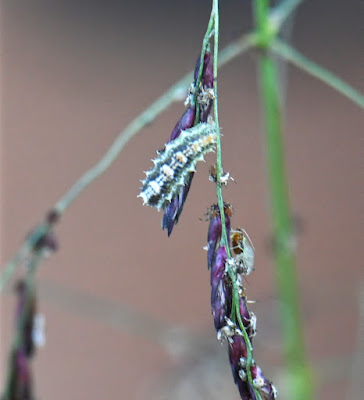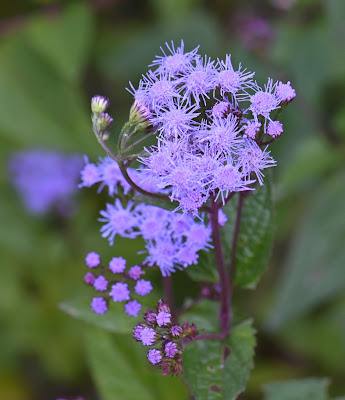Ramble Report for September 22, 2022
Leader for today's Ramble: Linda
Authors of today’s Ramble report: Linda. Comments, edits, and suggestions for the report can be sent to Linda at Lchafin@uga.edu.
Insect
identifications: Don
Hunter. Don't miss some amazing insect photos taken by Don earlier in the week.
Link to Don’s Facebook album for this Ramble. All the photos that appear in this report, unless otherwise credited, were taken by Don Hunter.
Number of Ramblers today: 14
Today's
emphasis: Warm-season grasses
Reading: This is the reading from the September 30, 2021 ramble that focused on grasses -- an excerpt from An Almanac for Moderns, by Donald Culross Peattie:
Show and Tell:
Linda brought in a specimen of Johnson Grass, in the genus Sorghum, one of the top ten most noxious weed species globally. It grows throughout Georgia in disturbed areas such as roadsides, pastures, and abandoned fields, and is resistant to the herbicide glyphosate. Originally introduced as a forage grass, it was later discovered to contain enough hydrogen cyanide to kill cattle and horses if eaten in large amounts. Linda brought in the specimen since Johnson Grass can be confused with two other large grasses, the natives Silver Plume Grass and Yellow Indian Grass. Though their seed heads are dissimilar, all have large leaves with stout, white midveins.
Announcements/Interesting Things to Note:
Dale reminded us of an art exhibit by three local landscape artists – Philip Juras, John Cleaveland, and Julyan Davis – opening tonight at the Leathers Building, 6-8pm.
Janisse Ray will be speaking at the Georgia Museum of Art --“The Art of a Place Called Longleaf” -- on Thursday, November 17, 5:30. Admission is free but you have to reserve a ticket here.
Today's Route: We left the Children’s Garden arbor and headed toward the powerline right-of-way through the Shade Garden, turning north into the Elaine Nash Prairie, then turning south through the prairie restoration area and the lower, floodplain portion of the right-of-way.
A Brief Introduction to Warm Season Grasses in Georgia's Piedmont
Grasses
generally fall into one of two groups.

Warm season grasses have their peak vegetative growth in midsummer; they thrive at temperatures of 90-95⁰ F. They flower in late summer and early fall, and rarely overwinter. With a couple of notable exceptions, all the grasses we looked at today are warm-season.
Cool- and warm-season grasses also differ physiologically, having different types of photosynthesis.
Grasses also fall into one of two growth forms: Sod-forming grasses form a dense turf by an extensive web of rhizomes or stolons; they grow so densely that there is little room for birds, small mammals, or insects to move around. They are typically shallowly rooted. All lawn grasses in Georgia are exotic turf grasses, e.g. Bermuda grass, Kentucky Bluegrass, St. Augustine, Zoysia, Fescue, etc.
 |
| Turf grass soil profile |
Bunch grasses form tufts, tussocks, bunches, or clumps. Their tufted growth form leaves patches of bare soil between clumps that allow animals to nest, travel, and feed on dropped seed. Bunch grasses are typically deeply rooted. In the graphic below, the deepest roots are at 15 feet below the surface. All of Georgia’s native grasses are bunch grasses, though it is unlikely that any Piedmont grasses are able to penetrate the clay subsoil to such depths.
 |
OBSERVATIONS:
River Oats is a good grass to learn from – most of its parts are visible without magnification. The "fish-on-a-pole" dangling at the tip of a slender stalk is a cluster of flowers called a spikelet (in many species of grasses the flower cluster is more or less spike-shaped.) The River Oats spikelet is oval and flattened; it's composed of 6-17 flattened florets (grass flowers are so small and so different from other types of flowering plants they are called florets). Each floret contains tiny structures that are roughly analogous to the sepal and petal of "normal" flowers, plus pollen-producing stamens and an ovary-containing pistil. All grasses are wind-pollinated so they don't need to attract pollinators with bright colors or enticing smells. They do need to have their reproductive parts prominently exposed to passing wind currents.
 |
|
River Oats seed head (left) with
many spikelets, |
River Oats is actually a cool-season grass that flowers in late spring; the spikelets persist on the plants and drop their seeds in late summer and fall.
Big Top Love Grass has a large, airy seed head up to 3 feet tall and 16 inches wide, held at the top of a short stem. The spikelets are very small, about 1/10 of an inch long, and are held at the tips of stiff, wiry branches. Each spikelet has only 2-6 florets. Leaves are held at ground level.
 |
| Bigtop Love Grass |
There's a lot to love about Love Grasses (genus Eragrostis), one thing being their seed dispersal method: in late fall, when their stems dry, the large seed heads break off and tumble across the landscape, scattering seeds. Another is that their delicate branches catch the dew in the early morning; before the sun burns the dew off, a mass of these plants looks like a cloud floating along the ground. A sister species, Purple Love Grass, forms a smaller but even more glorious pink mist.
 |
| Purple Love Grass |
Purple Top, aka Greasy Grass, also has a red or purple cast to its seed head but it would never be mistaken for Purple Love Grass. Its stem is tall, erect, and topped by a pyramid-shaped seed head. The branches of the seed head arc gracefully downward, bearing numerous spikelets coated with red or purple wax. If you pass the seed head through your closed fist, the greasy coating will stain your palm.
 |
| Purple Top or Greasy Grass photos by Janie K. Marlow |
 |
| Purple Top spikelets with larva
of a Four-speckled Hover Fly dining on aphids |
Panic Grasses are really tough to identify but a common Georgia Piedmont species, Beaked Panic Grass, is relatively easy, distinguished by the tiny beak at the tip of its spikelet.
 |
| This profile of a Beaked
Panic Grass seed head highlights the pointed beaks at the tip of each spikelet. |
Although Panic Grasses have been causing breakdowns among botanists for at least two centuries (there are more than 450 species worldwide!), the genus is not named for a nervous condition, but derives from the Latin root word 'pani-' meaning bread (thanks, Avis!). Some species of Panicum were crop plants in antiquity, including millet (Panicum miliaceum), domesticated about 10,000 years ago.
Silver Plume Grass
is the largest grass in the Nash Prairie. Once it reaches flowering size it is easy to identify. Its stems are stout and
5-10 feet tall, topped with a silvery-pink fan of flowering spikes that
eventually mature to a large, tan, fluffy plume.
 |
| A stand of Silver Plume
Grass in the Nash Prairie – the seed heads are silvery-pink and just beginning to mature. |
The wide leaves of Silver Plume Grass have a thick white midvein resemble those of the evil Johnson Grass but Silver Plume leaves have a patch of hairs at the junction of sheath and blade.
 |
| Leaf blade of Silver Plume
Grass showing the stout white midvein. The patch of hairs at the base of the blade (top of photo) distinguish it from other grasses with similar midveins. |
Perennial Foxtail Grass is a native Foxtail that lives in clearings, ditches, and other disturbed areas, especially in wet areas. Its seed heads are spikes densely packed with many spikelets and many white bristles. It is distinguished from the exotic and invasive Yellow Foxtail which has yellow seed heads.
 |
| Seed head of Perennial Foxtail Grass |
Yellow Indian Grass may be the Piedmont's most beautiful grass. Its vegetation is lush and bluish-green, its stems are robust, and its seed heads are a rich, glossy, orange- or golden-yellow. It is another Johnson Grass look-alike, at least in its leaves, but has a funny little ligule that resembles either a pair of terrier ears or a gun sight, depending on your life experience.
 |
| Ramblers examining the leaves of Yellow Indian Grass |
 |
| Yellow Indian Grass ligule possibly resembling terrier ears or maybe a gun sight photo by Janie K. Marlow |
 |
| Smut Grass infected with Bipolaris
fungus photo credit |
There's a lot going on besides grasses in the right-of-way this week. Here's a gallery of Don's plant photos from this week's ramble...
 |
| Maryland Golden-aster |
 |
| Camphorweed |
 |
| Blue Mist Flower |
 |
| Tall Goldenrod |
 |
| Red Morning-glory |
 |
| Tall Ironweed |
The wingstems and crownbeards in the genus Verbesina are at peak flower now.
 |
| Alternate-leaf Wingstem |
 |
| Southern Crownbeard |
 |
| White Crownbeard |
There are so many tall, showy, fall-flowering plants that the smartweeds are easily overlooked. We stopped to look at four species today: Dotted Smartweed, Arrow-leaf Tearthumb, Longbristle Smartweed, and (in the Shade Garden) a cultivar of Virginia Jumpseed called ‘Painter’s Palette.’
 |
| Long-bristle Smartweed (left) and Dotted Smartweed (right) |
All species in the Smartweed genus (Persicaria, formerly Polygonum) have a distinctive feature: at the base of their leaf stalks there is a short, green or brown tube that encircles the stem just above where the leaf base attaches. It is called an ocrea. It may or may not be fringed with bristles along the top – this is an important trait to look for.
 |
| Arrow-leaf
Tear-thumb has lines of sharp spines on both leaves and stems. Its flowers are usually white but occasionally pink. |
 |
| Don searching the White Crownbeard population for some cool photo ops |
SUMMARY OF OBSERVED SPECIES
Cardinal Flower Lobelia cardinalis
Jumpseed/Ladie’s Thumb ‘Painter’s Palette’ Tovara virginiana
Hurricane/Surprise Lily Lycoris radiata
Sweetshrub Calycanthus floridus
River Oats Chasmanthium latifolium
Bigtop Lovegrass Eragrostis hirsuta
Little Bluestem Grass Schizachyrium scoparium
Purple Top/Grease Grass Tridens flavus
Four-speckled Hover Fly (larva) Dioprosopa clavata
Aphid, not specified Family Aphididae
Southern Mountainmint Pycnanthemum pycnanthemoides
Beaked Panicgrass Panicum anceps, synonym Coleataenia anceps
Silver Plume Grass Erianthus alopecuroides
Purple Lovegrass Eragrostis spectabilis
Perennial Foxtail-grass Setaria parviflora
White Crownbeard/Frostweed Verbesina virginica
Wingstem Verbesina alternifolia
Yellow Crownbeard Verbesina occidentalis
Elephants Foot Elephantopus tomentosus
Maryland Goldenaster Chrysopsis mariana
Velvet Witchgrass Dichanthelium scoparium
Smut Grass Sporobolus indicus
Yellow Indian Grass Sorghastrum nutans
White Flat-topped Goldenrod Solidago ptarmicoides
Tall Goldenrod Solidago altissima
Climbing False Buckwheat Fallopia scandens
Tall Ironweed Vernonia gigantea
Dotted Smartweed Polygonum punctatum, synonym Persicaria punctatum
Camphorweed Pluchea odorata
Arrow-leaf Tearthumb Polygonum sagittatum, synonym Persicaria sagittatum
Pennsylvania Smartweed Polygonum pensylvanicum, synonym Persicaria p.
Blue Mistflower Conoclinium coelestinum
Red Morning Glory Ipomoea hederifolia
Spotted Horsemint Monarda punctata
Purple Passionflower Passiflora incarnata




